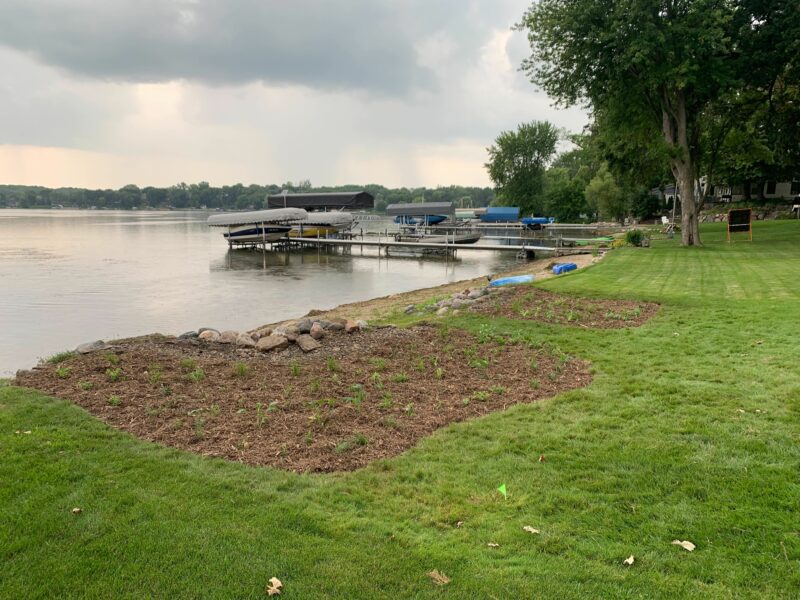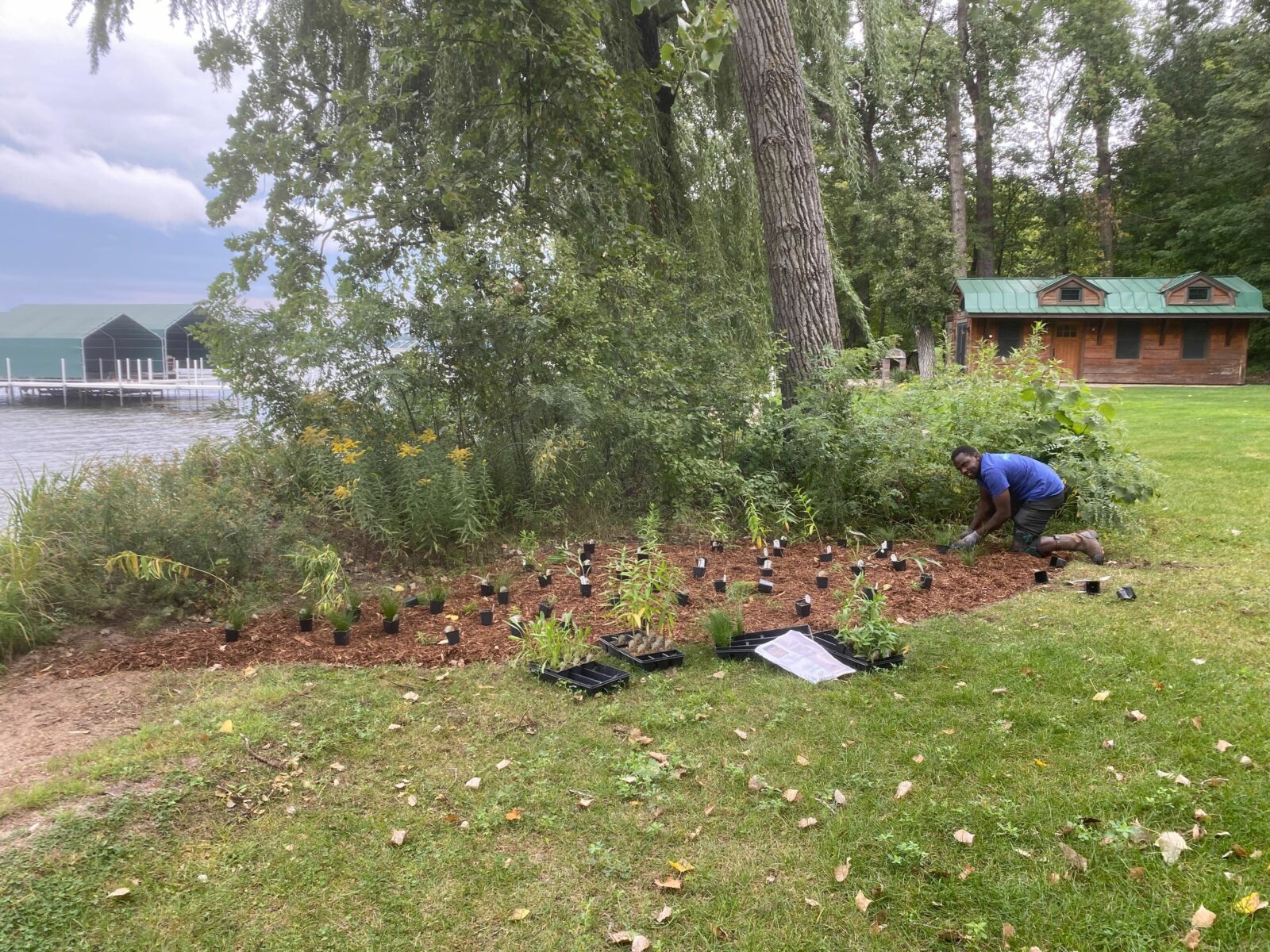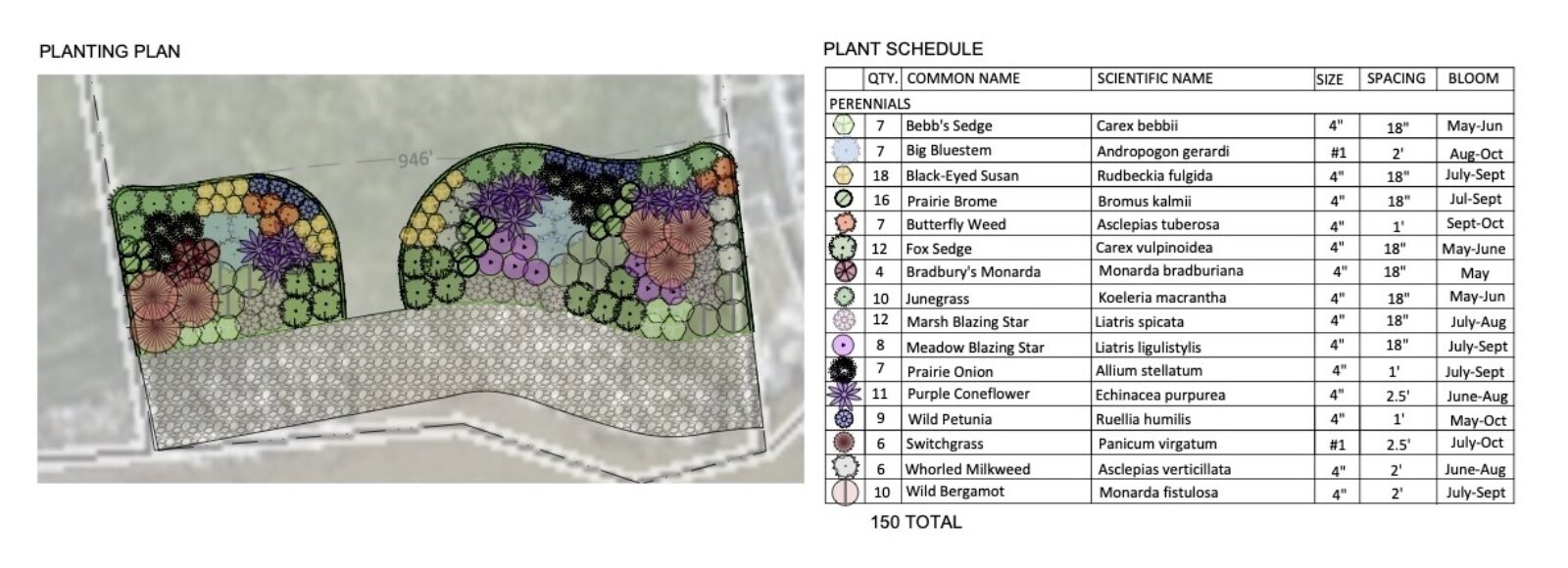
On a summer day at Lake Minnewashta, Conservation Corps of Minnesota & Iowa and Metro Blooms Design+Build crew members gathered in a resident’s yard to remove a large patch of sod and shape out a new garden bed. After a long day of digging, mulching, and planting, a new spread of small green tufts dotted the shoreline—a diverse mix of native plants including Bebb’s sedge, black-eyed Susan, marsh blazing star and wild bergamot. In time, these plants will fill in and create a buffer to help provide pollinator habitat and, with their deep roots, protect the water quality of Lake Minnewashta.
This is just one of four community-focused runoff projects in the last two years at Lake Minnewashta. As part of Metro Blooms Design+Build’s Neighborhood of Raingardens program, the Lake Minnewashta Preservation Association (LMPA), Carver County Soil and Water Conservation District, and the City of Chanhassen have been getting lakeshore residents involved in creating native plantings and buffers to increase habitat and help filter stormwater runoff.
“Native plant species provide fish and wildlife habitat and soil stabilization through their long roots and stems,” says Jennifer Moeller, Neighborhood Project Manager and Landscape Designer at Metro Blooms Design+Build. Some native plants, such as Bebb’s sedge, thrive in partially submerged environments, while other native plants like blazing stars and bergamot prefer a drying environment. As their roots grow deeper, they help stabilize the soil and become a natural woven filter for runoff, Moeller explains.
Filtering stormwater runoff that ends up in our lakes and rivers is an important step towards improving Minnesota’s water quality. With almost 12,000 lakes and 6,500 natural rivers and streams, Minnesota has an abundance of water resources. However, 56% of our state’s water bodies fail to meet state water quality standards. In 2022 alone, 305 lakes and streams were added to Minnesota’s impaired waters list. One big reason for that? Our loss of natural shorelines.

“Before human development, lakes, rivers, ponds, and any other bodies of water were all kept functioning cleanly within their ecosystems. Much of this is due to the vegetative cover surrounding the water,” explains Kyle Thurston, a Landscape Design Assistant with Metro Blooms Design+Build who helped with the Lake Minnewashta planting. As native vegetation has been gradually replaced with impervious surfaces like roads, houses, and industrial buildings, pollutants and excess nutrients easily flow over these surfaces and directly into the water. Today, about half of Minnesotan’s natural shorelines have been lost to development.
“Stormwater from impervious surfaces, lawns, bare soil and lake basins all come in contact at shorelines,” Moeller shares. “It’s vitally important to design and install these areas with care.” Even lawns do little to protect the shoreline and water. Typical turfgrass roots barely sink deeper than a few inches, not enough for infiltration of a lot of water. According to the Natural Shoreline Partnership, mowed shorelines allow 7 to 9 times more pollutants to enter the lake than a more naturally vegetated shoreline. Replanting shorelines with native species provides more effective filtration.
Restoring Resilient Shores
All of us are responsible for protecting Minnesota’s shorelines. Through the Shoreland Management Act, the Minnesota Department of Natural Resources sets shoreland regulations and shoreland development standards for local governments to implement. But community-led efforts involving residents, like at Lake Minnewashta, are critical for restoring our shores. Counties and cities then implement those regulations through local zoning. The landscaping decisions you make on your property have a direct impact on the health of your lake, stream, or river.
If you are lucky to have undisturbed shorelines, keep it that way! It’s much harder to restore a natural shore once it’s gone. If you don’t, consider reviving your shoreline to its natural state by removing retaining walls and old docks, installing erosion control and incorporating native plants that bring water quality benefits and increased wildlife habitat to the surrounding area. Even adding an unmowed strip of native vegetation between developed land and the water’s edge is a great start towards restoring shoreline.
|
|

“If created well, the shoreline buffer can preserve and greatly enhance a water body’s water clarity, cleanliness, and habitat value,” Moeller shares. “It can also reduce soil erosion, and property loss over time.” Beyond water quality protection, natural shorelines cost less to maintain, adapt better to changes in precipitation and lake levels, and provide both beauty and privacy as plants fill in.
Shifting social norms is a necessary step in restoring our shores. Individuals and lake associations have a lot of opportunities to promote and build community around their lakes. While working on the Lake Minnewashta planting, Thurston was inspired by the other properties on the lakefront. “I felt a sense of reassurance glancing around… there’s beginnings of some impressive native plantings along the shoreline. Seeing the work we were doing and the impact it may have in encouraging others was a great feeling,” Thurston shares.
To learn more about how your neighborhood, lake association, or city can work with Metro Blooms to get raingardens and shoreline plantings in more yards, visit their Neighborhood of Raingardens page. For more ideas on how you can be a steward for your local river or lake (whether your own shoreline property or not), check out the resources below!
Resources:
- Minnesota Natural Shoreline Partnership 2023 Report
- Access the new Resilient Shorelines Online Learning Series
- Use the Minnesota Department of Natural Resource’s Restore Your Shore Tool for implementing your own project
- Browse best management practices to remediate shore erosion from the Minnesota Department of Natural Resources
- Check the status of your lake with the Minnesota Department of Natural Resources’ Lake Finder
- If you’re in the planning stages of a shoreline project, our Shoreline Planning worksheet guide walks you through questions to ask during a site assessment and whether you might need a permit.
- Don’t own lakeshore property but still want to help? Reduce pollution in runoff by adopting a storm drain near you
- Volunteer as a water monitor with the Minnesota Pollution Control Agency
- Interested in hiring somebody for your project? Check out the Blue Thumb Partner Finder and this guide for what questions to ask a landscape contractor from the Lower St. Croix Watershed Partnership
– Megan Reich, Metro Blooms Communications and Program Manager

